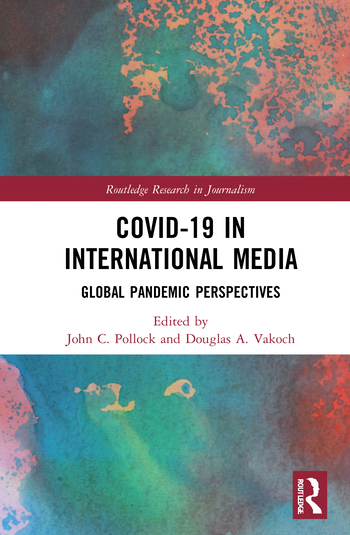While many college students may have experienced some pandemic fatigue and tired of the constant news reports about the number of cases and how to stay safe, six TCNJ students worked together to study and dissect the coverage, and came out of lockdown with a new title for their resumes: co-authors.
Miranda Crowley, Suchir Govindarajan, Abigail Lewis, Alexis Marta, Radhika Purandare, and James Sparano, all members of the Class of 2021, collaborated with communication studies and public health professor John Pollock last year on a chapter in COVID-19 in International Media: Global Pandemic Perspectives, a book recently published by Routledge.

Their chapter, “U.S. Nationwide COVID-19 Newspaper Coverage of State and Local Government Responses: Community Structure Theory and a ‘Vulnerability’ Pattern,” analyzed regional newspaper coverage of state and local government responses to COVID-19, and examined how that coverage is driven by the demographics of the community.
“We primarily looked at articles dealing with school reopening policies, mask mandates, and economic relief during the pandemic,” explained Crowley, who is currently enrolled in the Master of Public Administration program at the Maxwell School of Citizenship and Public Affairs at Syracuse University.
As a team, they decided whether or not each article spoke positively, negatively, or neutrally about how state and local governments responded to the virus. With that data and city-level population data from the communities served by each newspaper, the team ran statistical analyses to look for patterns between certain community characteristics and media coverage.
“Our study found that the more vulnerable the city — more poverty, more unemployment, greater crime rate — the less positive the coverage of state and local government responses to COVID-19,” Crowley said.
Over the course of many late-night Zoom calls, the team learned how to standardize data collection, resolve research conflicts, edit manuscripts, and apply for publication.
“Prior to participating in this study, I don’t think I fully grasped the importance of a good research team,” she said.”With seven co-authors, our team was quite large, but effective collaboration became one of the most important components of the research process.”
Each co-author brought different skills to the project. Some were narrative-focused, others brought insight from public health and biology, and others were data-driven analysts.
“In an increasingly connected age, nothing and no one exists in a vacuum — not even a research study conducted in a nationwide lockdown,” Crowley said. “I walked away from this project with an overwhelming appreciation for the people I worked with and the importance of teamwork.”
As they go on to future studies and careers, the co-authors agree: They value the experience gained from the project.
“As a public health master’s student in nutrition at Johns Hopkins University, group work and cross-sector collaboration is integral to each one of my classes,” Marta said. “I feel so prepared for organizing and participating in even faster-paced graduate studies.”
— Emily W. Dodd ’03 and Julia Meehan ’22
